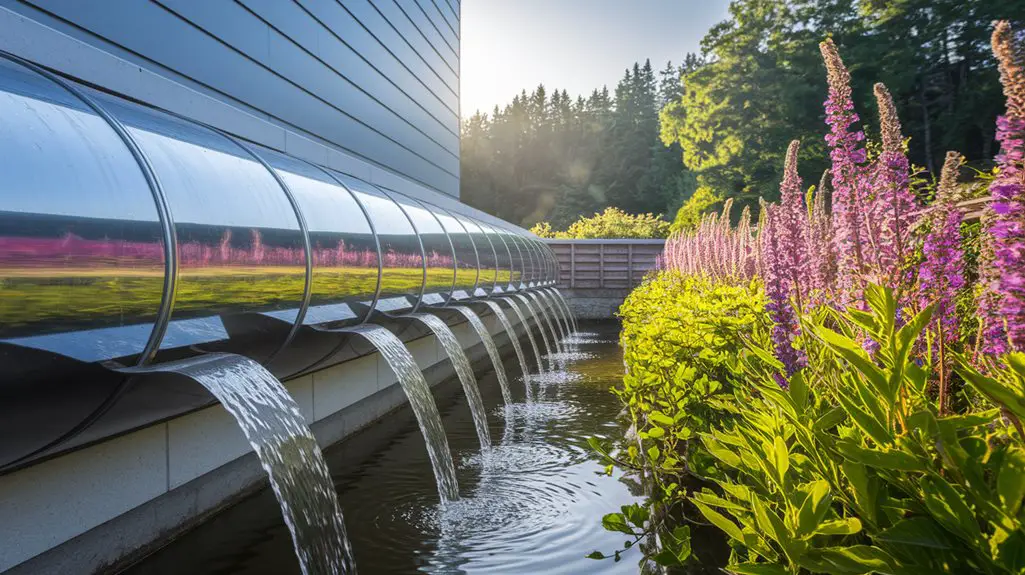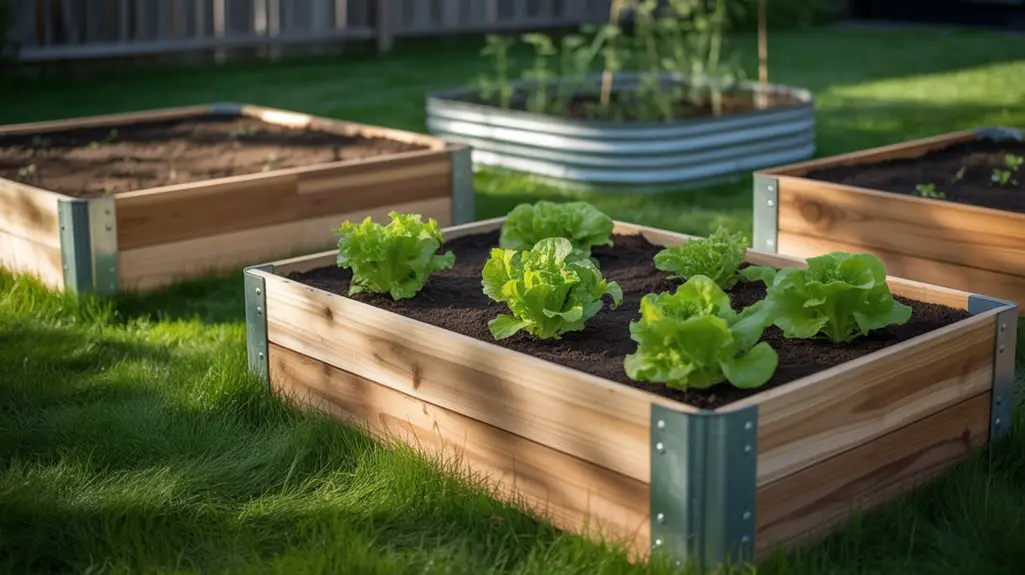Like the ancient cisterns of Rome that sustained a civilization, today’s rainwater harvesting systems offer practical solutions to modern water challenges. You’ll find they provide significant financial savings while reducing your environmental footprint in ways you might not expect. Beyond conservation, these systems create resilient landscapes that withstand drought conditions and enhance soil health. The strategic integration of rainwater collection into your property could transform both its functionality and sustainability in surprising ways.
Reducing Water Bills Through Self-Sufficient Garden Irrigation
When implemented correctly, rainwater harvesting systems can substantially reduce your water bills by providing a self-sufficient irrigation solution for gardens.
A typical residential system capturing runoff from a 1,000 square foot roof can collect approximately 600 gallons of water from just one inch of rainfall.
You’ll maximize efficiency by integrating drip irrigation systems that deliver water directly to plant roots, minimizing evaporation losses.
Modern setups often include filtration components, pressure pumps, and programmable timers to automate distribution.
During peak growing seasons, these systems can offset 40-80% of municipal water usage for landscape maintenance.
The investment typically achieves ROI within 2-5 years, depending on local water rates, annual rainfall patterns, and system complexity.
Maintenance requirements remain minimal—primarily filter cleaning and occasional system inspection.
Additionally, a well-designed system can utilize simple rainwater harvesting setup techniques to further enhance water collection efficiency.
Environmental Impact and Conservation of Natural Resources

Beyond financial savings, rainwater harvesting systems offer substantial environmental benefits through resource conservation.
You’ll reduce demand on municipal water supplies by up to 40%, decreasing energy required for treatment and distribution. This translates to lower carbon emissions in water infrastructure operations.
By capturing precipitation where it falls, you’re mitigating stormwater runoff—a significant cause of erosion, flooding, and water pollution.
The system prevents contaminants like fertilizers, oils, and debris from entering waterways. Collected rainwater also contains natural nitrogen, benefiting plants without chemical additives.
During drought conditions, your harvested reserves provide critical supplemental water when restrictions limit municipal usage.
This distributed approach to water management creates resilience in local watersheds and helps maintain groundwater supplies by allowing natural recharge cycles to function properly. Additionally, sustainable outdoor water features like rainwater harvesting systems enhance the aesthetic value of your landscape while promoting conservation efforts.
Creating Eco-Friendly Backyard Oasis With Harvested Rainwater

Transforming your outdoor space into a sustainable sanctuary becomes achievable through strategic rainwater harvesting implementation.
Begin by installing collection systems at downspouts, directing water to storage tanks positioned for gravity-fed distribution. Select native plant species that thrive with minimal irrigation demands while supporting local pollinators and wildlife.
Integrate permeable pathways and bioswales that channel excess water to designated absorption zones, reducing runoff and maximizing groundwater recharge.
You’ll optimize resource efficiency by incorporating drip irrigation systems with timers that deliver precise amounts of harvested water directly to plant root zones.
This systematic approach creates a self-sustaining ecosystem that functions independently from municipal water supplies during dry periods. Additionally, using rainwater collection barrels can further enhance your system’s efficiency and effectiveness.
Your backyard oasis won’t just conserve water—it’ll demonstrate ecological stewardship while providing a vibrant outdoor living environment throughout changing weather patterns.
Mitigating Soil Erosion and Improving Landscape Health
Rainwater harvesting systems offer significant soil stabilization benefits that extend well beyond water conservation advantages. By capturing precipitation before it flows across your property, you’re preventing the displacement of topsoil that typically occurs during heavy rainfall events.
This controlled water management reduces runoff velocity by 70-90%, allowing deeper soil penetration.
You’ll notice improved soil structure as harvested rainwater delivers gentler irrigation compared to municipal sources. The natural pH (5.5-6.5) of rainwater enhances nutrient availability and microbial activity, creating healthier root zones.
Strategic placement of collection points and dispersal systems effectively redirects water to erosion-prone areas.
Additionally, your landscape’s drought resilience improves as consistent moisture levels maintain soil cohesion during dry periods, preventing the cracking and destabilization that precede erosion events. Moreover, the use of innovative rainwater systems can further enhance soil health by optimizing the distribution of collected water.
Design Integration for Aesthetic and Functional Outdoor Spaces
When properly integrated into landscape design, rainwater harvesting systems transcend mere utility to become distinctive aesthetic elements that enhance outdoor spaces.
You’ll find that well-designed rain gardens, decorative barrels, and sculptural cisterns can serve as focal points while fulfilling their water collection functions.
Consider incorporating permeable pathways that direct water to collection points, combining flow management with accessible garden routes.
Vertical garden walls fed by harvested rainwater maximize space efficiency in urban settings.
For thorough integration, you can connect multiple collection points through subsurface drainage that feeds central storage systems.
The most successful designs align water harvesting with your property’s natural topography, creating a seamless flow that appears intentional rather than retrofitted.
This systematic approach guarantees both peak water capture and harmonious landscape aesthetics. Additionally, implementing eco-friendly rainwater harvesting practices can further enhance your landscape’s sustainability.
Conclusion
By implementing rainwater harvesting systems, you’ll achieve significant cost savings while contributing to environmental conservation. Isn’t it logical to utilize a free resource that simultaneously prevents erosion and supports ecosystem health? These systems integrate seamlessly into existing landscapes, providing drought resistance while enhancing soil quality. Your analysis should consider both immediate benefits and long-term ROI, as these systems systematically address multiple ecological and economic variables simultaneously.




